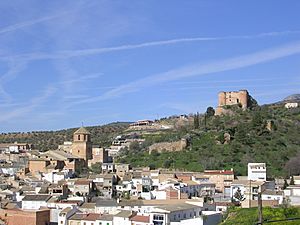Huelma facts for kids
Quick facts for kids
Huelma
|
|||
|---|---|---|---|
 |
|||
|
|||
| Country | |||
| Autonomous community |
|||
| Province | |||
| Municipality | Huelma | ||
| Area | |||
| • Total | 250.29 km2 (96.64 sq mi) | ||
| Elevation | 981 m (3,219 ft) | ||
| Population
(2018)
|
|||
| • Total | 5,845 | ||
| • Density | 23.3529/km2 (60.484/sq mi) | ||
| Time zone | UTC+1 (CET) | ||
| • Summer (DST) | UTC+2 (CEST) | ||
Huelma is a city located in the province of Jaén, in southern Spain. In 2018, about 5,845 people lived there. It's a place with a rich history and beautiful natural surroundings.
Contents
What's in a Name?
The name Huelma might come from an old Arabic phrase, Walda(t) al-ma. This means 'water source'. It was used between the 11th and 13th centuries. Another idea is that the name comes from the Berber word Guelma. There's even a city called Guelma in Algeria with the same name.
Discovering Huelma's Nature
Huelma is part of the amazing Parque natural de Sierra Mágina. This is a large natural park that surrounds the Sierra Mágina mountain range. It's a perfect spot for outdoor adventures.
Hiking and Biking Trails
You can find many exciting hiking trails here. Some paths lead up to Pico Mágina, which is a tall mountain peak. If you love mountain biking, there are also special BTT (mountain bike) tracks. These tracks wind through the beautiful mountains.
Unique Geological Sights
The park also has cool geological features. You can see karst formations in Sierra Mágina. These are unique rock shapes created by water. There's also the Cabeza Montosa guyot. A guyot is like a flat-topped underwater mountain.
A Glimpse into Huelma's Past
The area around the Jandulilla river has been home to people for a very long time. Ancient Iberian remains have been found at a place called Cortijo del Pajarillo. This shows that people lived here thousands of years ago.
Frontier Land and Castles
For almost 200 years, Huelma was a borderland. It was between the kingdom of Castile and the Nasrid kingdom of Granada. This was after the Pacto de Jaén was signed in 1246. In 1438, Íñigo López de Mendoza, 1st Marquis of Santillana took control of Huelma for the Castilians.
Later, in 1463, King Henry IV of Castile gave Huelma to Diego Fernández de la Cueva, 1st Viscount of Huelma. He became the lord of the area.
Famous Buildings
Two important buildings were constructed in the 16th century. These were the Castle of the Viscounts of Huelma and the Inmaculada Concepción Church. Both were built in the Spanish Renaissance style. A famous architect named Andrés de Vandelvira designed the church.
Sadly, the castle has been in ruins since the 17th century. But the Inmaculada Concepción Church is still standing. Many people consider it one of Vandelvira's best works.
Huelma in the 1800s
In the 19th century, some changes happened in Huelma. A former convent of the Order of Saint Augustine was sold. This convent used to be next to the town hall. Old maps and writings from the 1800s describe Huelma. They show its grid plan from the 17th century.
Must-See Places in Huelma
Huelma has five special places recognized as Bien de Interés Cultural (BIC). This means they are important cultural sites.
- Huelma Castle: This 16th-century castle is also known as the Castle of the Duke of Alburquerque.
- Inmaculada Concepción Church: This beautiful Renaissance church was built by the famous architect Andrés de Vandelvira.
- Solera Castle: This castle is from the 15th century and is in the nearby village of Solera. It was updated in 2006.
- Cortijo El Pajarillo: This is an Iberian archeological site. The ancient items found here are now in the Iberian Museum in Jaén.
- Huelma's Historic Centre: The old part of the city itself is also a protected cultural site.
Famous People from Huelma
- Rafael Lopez Guzman: A professor of art history at the University of Granada.
- Sebastián Martos: A talented athlete.
See also
 In Spanish: Huelma para niños
In Spanish: Huelma para niños






